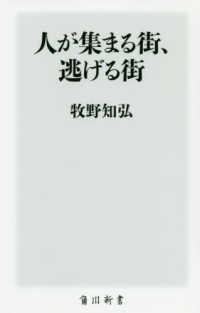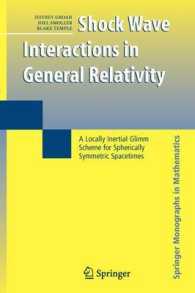- ホーム
- > 洋書
- > 英文書
- > Psychology
Full Description
The different psychopathologic syndromes show in an exaggerated and caricatural manner the basic structures of human existence. These structures not only characterize psychopathology, but they also determine the highest forms of culture. This is the credo of Freud's anthropology. This anthropology implies that humans are beings of the in-between. The human being is essentially tied up between pathology and culture, and there is no 'normal position' that can be defined in a theoretically convincing manner. The authors of this book call this Freudian anthropology a patho-analysis of existence or a clinical anthropology. This anthropology gives a new meaning to the Nietzschean dictum that the human being is a 'sick animal'. Freud, and later Lacan, first developed this anthropological insight in relation to hysteria (in its relation to literature). This patho-analytic perspective progressively disappears in Freud's texts after 1905. This book reveals the crucial moments of that development. In doing so, it becomes clear not only that Freud introduced the Oedipus complex much later than is usually assumed, but also that the theory of the Oedipus complex is irreconcilable with the project of a clinical anthropology. The authors not only examine the philosophical meaning of this thesis in the work of Freud. They also examine its avatars in the texts of Jacques Lacan and show how this project of a patho-analysis of existence inevitably obliges us to formulate a non-oedipal psychoanalytic anthropology.
This publication is GPRC-labeled (Guaranteed Peer-Reviewed Content).
Contents
Table of Contents
Acknowledgements
Introduction
A Clinical Anthropology of Hysteria
Hysteria as a Philosophical Problem
Chapter 1
Between Trauma and Disposition
The Specific Aetiology of Hysteria in Freud's Early Works
Introduction: From Real Trauma to Oedipal Phantasy?
1. Trauma and Disposition in Studies on Hysteria
2. The Seduction Theory
3. After the Theory of Seduction
Conclusion 43
Chapter 2
Dora
Symptom, Trauma and Phantasy in Freud's Analysis of Dora
Introduction
1. Two Traumas
2. The Meaning of Dora's Symptoms
3. The Oedipal Legend in the Case of Dora
4. Bisexuality and its Consequences
Conclusion: Dora's un-Oedipal Desires
Chapter 3
From Day-dream to Novel
On Hysterical Phantasy and Literary Fiction
Introduction: a Disposition towards Literature?
1. Hysterical Phantasying
2. The Novel and Hysteria
3. Sources of Pleasure - the Joke and Literature
Conclusion: The Novel as Sublimation of Hysteria
Chapter 4
The Indifference of a Healthy Lesbian Bisexuality versus the Oedipus Complex
Introduction
1. From Bisexuality to the Oedipus Complex
2. From Oedipus Complex to Bisexuality
Conclusion
Chapter 5
Lacan's Structuralist Rereading of Dora
Introduction
1. Structure versus Psychogenesis
2. The Female Oedipus Complex: Frustration and Gift
3. L acan's Reading of Fragment of an Analysis of a Case of Hysteria ("Dora")
4. Dora and the L-scheme
5. The Lesson of Lévi-Strauss
6. The Hysterical Desire for an Unfulfilled Desire: the Dream of the Beautiful Butcher's Wife
7. Dora and the Dream of the Beautiful Butcher's Wife
Conclusion
Chapter 6
Lacan and the Homosexual Young Woman: between Pathology and Poetry?
Introduction
1. Dora versus the Homosexual Young Woman
2. A Lacanian Clinical Anthropology of Hysteria and Perversion?
Conclusion
Chapter 7
Beyond Oedipus?
Introduction
1. Freud reads Sophocles
2. A Psychoanalytical Origin Tale: Totem and Taboo
3. Freud's Dream
4. Castration as the Truth of the Oedipus Complex
5. Oedipus as Incarnation of the Master
6. Dora and the Search for a Master
Conclusion
Chapter 8
Return to Freud?
Lacan's Pathoanalysis of Hysteria
Introduction
1. The formulas of Sexuation
2. Hysteria and the Formulas of Sexuation
3. Courtly Love and the Jouissance of the Other
Conclusion 151
Conclusion
The Project of a Psychoanalytical Anthropology in Freud and Lacan
1. Freud and Hysteria
2. Hysteria and Literature
3. The Oedipal Trap
4. Development versus Structure
5. The Human as a Being of the In-between
6. The Hysterical Subject, its Master and Female Jouissance
7. Beyond Hysteria...
8. Freud versus Lacan: the Position of Science
References
Index








